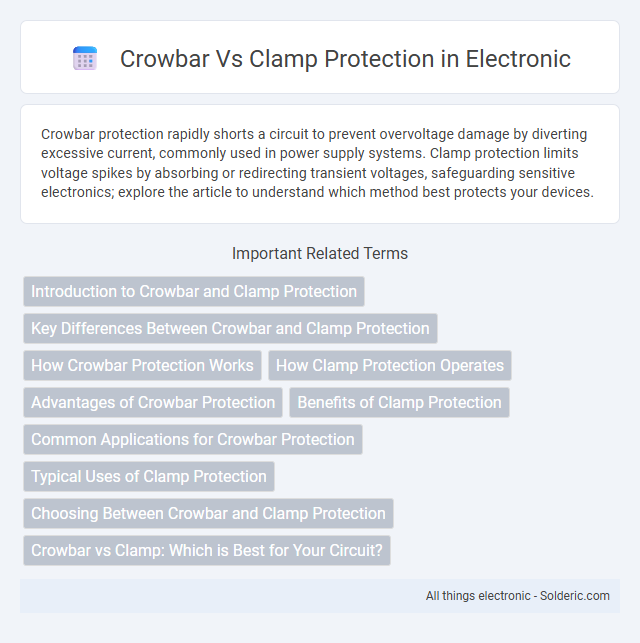Crowbar protection rapidly shorts a circuit to prevent overvoltage damage by diverting excessive current, commonly used in power supply systems. Clamp protection limits voltage spikes by absorbing or redirecting transient voltages, safeguarding sensitive electronics; explore the article to understand which method best protects your devices.
Comparison Table
| Feature | Crowbar Protection | Clamp Protection |
|---|---|---|
| Function | Limits voltage by quickly shorting the circuit when threshold is exceeded | Diverts excess voltage by clamping it to a safe level |
| Response Time | Very fast; immediate short-circuit action | Fast; depends on clamping device characteristics |
| Voltage Handling | Active during overvoltage as a near-short circuit | Maintains voltage below maximum clamp level |
| Energy Dissipation | Dissipates energy via short circuit path | Dissipates energy by limiting voltage spikes |
| Common Applications | Power supply overvoltage protection, battery management | Surge protection in sensitive electronics, voltage transient suppression |
| Typical Components | Thyristors, SCRs, crowbar circuits | Metal oxide varistors (MOVs), transient voltage suppression (TVS) diodes |
| Resetting | Requires power cycle or circuit reset after activation | Automatically resets after transient ends |
| Reliability | May cause permanent component stress or damage | Generally non-destructive and reusable |
Introduction to Crowbar and Clamp Protection
Crowbar and clamp protection are crucial methods in electrical circuits to guard against voltage surges and transient spikes. Crowbar protection works by creating a low-resistance path that rapidly shorts the power supply during overvoltage, effectively preventing damage to sensitive components. Clamp protection utilizes devices like transient voltage suppression diodes to absorb excess voltage and maintain your circuitry within safe operational limits.
Key Differences Between Crowbar and Clamp Protection
Crowbar protection rapidly shorts the circuit to ground during overvoltage events, providing immediate and robust voltage clamping, while clamp protection limits voltage by diverting excess current through a nonlinear resistor element without fully shorting the line. Crowbar circuits are typically used for severe faults requiring fast disconnection, offering a low-resistance path once triggered, whereas clamp protection is suited for transient voltage suppression with continuous operation under normal conditions. Your choice between these methods depends on the required response time and fault severity tolerance in the electrical system.
How Crowbar Protection Works
Crowbar protection functions by creating a low-resistance path to ground when overvoltage conditions occur, effectively short-circuiting the power supply to prevent damage to sensitive components. This rapid response mechanism detects voltage surges and triggers a thyristor or similar device to "crowbar" the voltage, forcing a current surge that activates protective fuses or circuit breakers. Your electronic circuits benefit from crowbar protection's reliable shutdown during faults, ensuring enhanced safety and preventing costly component failures.
How Clamp Protection Operates
Clamp protection operates by diverting excessive voltage or current away from sensitive electronic components through a controlled, low-resistance path, effectively clamping the signal to a safe level. It rapidly activates once the predefined threshold is exceeded, preventing damage from voltage spikes or transient surges. Unlike crowbar protection, which completely shorts the circuit to ground, clamp protection maintains circuit continuity while safeguarding components.
Advantages of Crowbar Protection
Crowbar protection offers rapid fault clearance by quickly shorting the system during overvoltage conditions, minimizing equipment damage and enhancing system reliability. Its design provides a robust response to transient surges, ensuring stable voltage regulation and reducing downtime. Crowbar circuits are especially advantageous in sensitive electronics, where precise and immediate protection prevents costly failures.
Benefits of Clamp Protection
Clamp protection offers reliable defense against voltage spikes by securely absorbing transient energy, preventing damage to sensitive electronic components. Its ability to provide fast response times and handle high current surges enhances system durability and minimizes downtime. This protection method is often preferred in industrial applications due to its robustness and long-term operational stability.
Common Applications for Crowbar Protection
Crowbar protection is commonly used in power electronics and industrial equipment to protect sensitive components from overvoltage conditions by quickly shorting the power supply to ground. You typically find crowbar circuits in DC power supplies, battery chargers, and motor controllers where rapid response to voltage spikes is critical. These applications benefit from crowbar protection's ability to minimize damage by safely diverting excessive current during transient overvoltage events.
Typical Uses of Clamp Protection
Clamp protection is typically used in electrical systems to prevent damage from transient voltage spikes by securely diverting excess current away from sensitive components. Common applications include surge protection in power supplies, telecommunications equipment, and industrial control systems. This method offers fast response times and reliable clamping voltage levels, ensuring enhanced protection and system longevity.
Choosing Between Crowbar and Clamp Protection
Selecting between crowbar and clamp protection hinges on the specific application requirements for voltage and current surge control. Crowbar protection quickly short-circuits the power supply during overvoltage events, providing fast and effective suppression but requiring robust components to handle the surge current. Clamp protection, often implemented with devices like TVS diodes or MOVs, limits voltage spikes by clamping the voltage to a safer level, offering a less disruptive response suited for sensitive electronics and continuous protection scenarios.
Crowbar vs Clamp: Which is Best for Your Circuit?
Crowbar protection rapidly shuts off power during overvoltage by triggering a low-resistance path, effectively protecting sensitive components, while clamp protection limits voltage spikes by diverting excess current without fully interrupting the circuit. Your choice depends on the specific sensitivity of your circuit and response time requirements; crowbars suit critical systems needing immediate cutoff, whereas clamps are ideal for handling transient surges with minimal disruption. Understanding voltage tolerance and failure mode analysis helps determine whether crowbar or clamp protection best safeguards your electronic devices.
crowbar vs clamp protection Infographic

 solderic.com
solderic.com